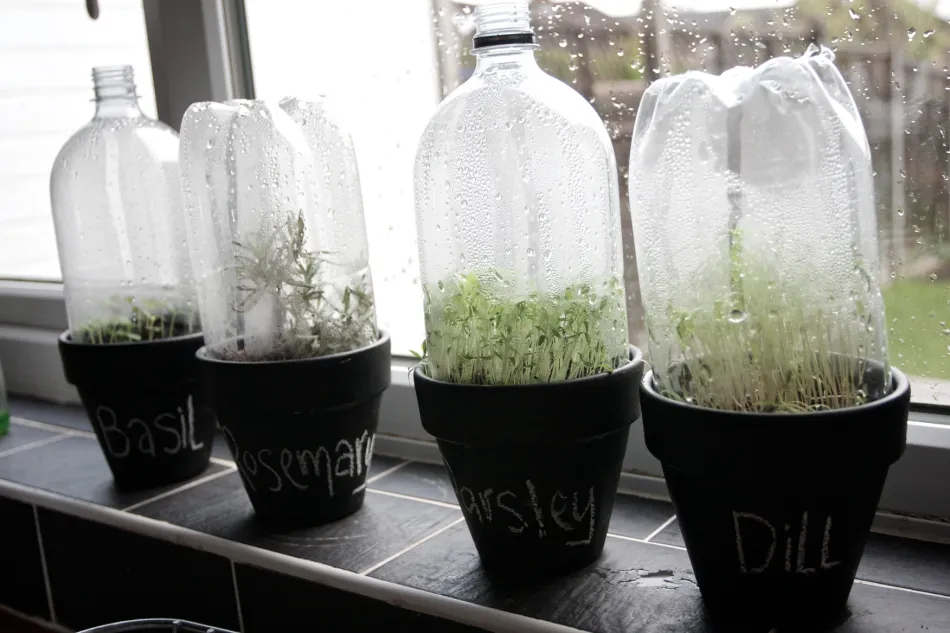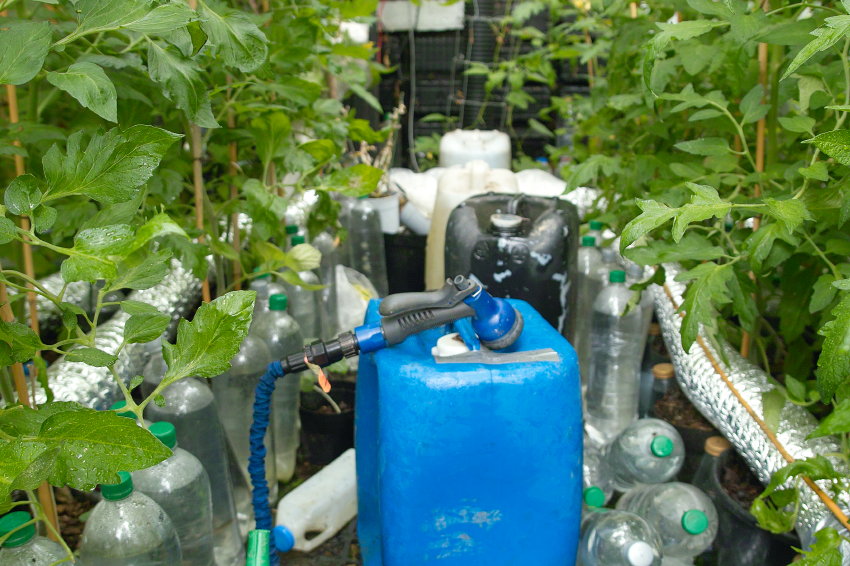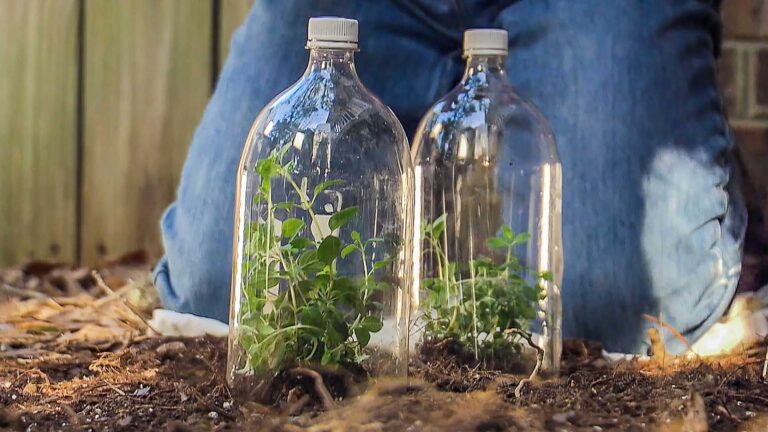Inside my lush greenhouse, surrounded by vibrant veggies and exotic plants. What’s got me excited? Something as simple as water bottles! Yes, you heard right, those everyday items we usually ignore. But here’s the surprise: they’ve become the real heroes of my greenhouse, keeping it warm and green in an eco-friendly way.
I wanted to heat my greenhouse in a greener and more responsible way. That’s when I stumbled upon this cool trick that’s good for both my plants and the environment. It’s all about using water bottles as a part of the greenhouse setup. Believe it or not, this technique can make the sun’s power work wonders for your plants, and it’s affordable and kind to the planet too.
Using water bottles for greenhouse heating offers several advantages, including cost-effectiveness, energy efficiency, even heating, low maintenance, DIY-friendliness, eco-friendliness, off-grid potential, heat retention, customization, and temperature stabilization. However, it may not be suitable for large commercial greenhouses or very cold climates, and temperature monitoring is essential for precise control.
How energy-efficient is water bottle greenhouse heating?

Exploring the energy efficiency of water bottle greenhouse heating in comparison to conventional methods unveils a promising avenue for eco-conscious growers.
Explanation of how water bottles store and release heat:
Water bottles are effective in greenhouse heating because of their thermal mass properties. They have the capacity to absorb and store heat during the day when temperatures are higher and release it slowly at night when it gets colder.
This process, known as thermal inertia, helps to stabilize temperature fluctuations within the greenhouse.
The water inside the bottles acts as a heat reservoir, absorbing excess heat during the day. And gradually radiating it back into the greenhouse during cooler periods, reducing the need for continuous heating.
Comparison to traditional heating methods (e.g., electric heaters, gas heaters):
When compared to traditional heating methods such as electric or gas heaters, water bottle heating systems have distinct advantages. Electric and gas heaters require continuous energy input, which can be costly and less efficient.
In contrast, water bottles primarily rely on passive heating, reducing energy consumption and operating costs significantly.
Additionally, water bottles offer more uniform heating, preventing localized overheating or cooling within the greenhouse, which can be problematic with conventional heaters.
Reduced energy consumption and cost savings:
Water bottle heating systems contribute to reduced energy consumption and substantial cost savings over time. By harnessing natural principles of heat storage and release, greenhouse owners can lower their energy bills.
Furthermore, reduced reliance on electricity or fossil fuels not only saves money but also lowers the greenhouse’s carbon footprint, making it a more sustainable and cost-effective heating solution.
What are the environmental advantages of using recycled water bottles?
Delving into the environmental benefits of utilizing recycled water bottles in greenhouse heating reveals a compelling case for sustainable agriculture.
Sustainability of using recycled or repurposed water bottles:
Using recycled or repurposed water bottles for greenhouse heating aligns with sustainable practices. Repurposing materials that would otherwise end up in landfills reduces waste and promotes resource conservation.
Furthermore, this approach not only makes use of existing resources but also decreases the demand for new materials, further benefiting the environment.
Reduction in carbon footprint compared to fossil fuel-based heating:
Traditional heating methods, such as fossil fuel-based systems, release greenhouse gasses into the atmosphere, contributing to climate change.
In contrast, water bottle heating systems have a smaller carbon footprint because they rely on stored solar energy and reduce the need for fossil fuels. This environmentally friendly aspect helps mitigate the greenhouse effect and supports a greener, more sustainable future.
Contribution to eco-friendly greenhouse practices:
Adopting water bottle heating systems in greenhouses is a step towards eco-friendly greenhouse management. It aligns with the broader goal of reducing environmental impact and embracing sustainable agricultural practices.
By minimizing reliance on non-renewable energy sources and reusing materials like water bottles, greenhouse owners can contribute to a more ecologically responsible and environmentally conscious approach to agriculture and horticulture.
How do water bottles help maintain steady greenhouse temperatures?
Discover the ingenious ways in which water bottles play a pivotal role in maintaining consistent greenhouse temperatures, fostering optimal conditions for plant growth.
Insulating properties of water bottles:
Water bottles, particularly those made from materials like plastic or glass, possess insulating properties. These materials have low thermal conductivity, meaning they do not readily transfer heat.
As a result, water bottles can effectively trap and store heat inside them. When placed in a greenhouse, these bottles act as a thermal buffer, reducing heat loss to the surroundings.
Moreover, this insulating effect helps maintain a stable temperature inside the greenhouse, especially during nighttime or cooler periods, by gradually releasing the stored heat and preventing rapid temperature drops.
Consistent temperature maintenance throughout the day and night:
Water bottles contribute to consistent temperature maintenance in greenhouses by addressing diurnal temperature variations.
During the day, when sunlight warms the greenhouse, water bottles absorb excess heat, preventing overheating.
As the temperature cools at night, the stored heat is slowly released, preventing drastic temperature fluctuations.
This balance ensures that plants experience relatively stable and optimal growing conditions, which is essential for healthy growth and crop yield.
Prevention of temperature fluctuations and cold spots:
Water bottles strategically placed throughout the greenhouse help prevent temperature fluctuations and cold spots. Traditional heating methods may lead to uneven heating, resulting in localized hot and cold areas within the greenhouse.
Water bottles distribute heat more evenly, eliminating cold spots and ensuring a uniform temperature throughout the space. This consistent temperature distribution is crucial for maintaining healthy and uniform plant growth.
Why are water bottle heating systems a low-maintenance solution?

Unveiling the reasons behind the low-maintenance appeal of water bottle heating systems in greenhouses.
Minimal upkeep required for water bottle heating systems:
Water bottle heating systems are known for their low maintenance requirements. Once set up, they generally operate passively, without the need for constant adjustments or monitoring.
Routine maintenance typically involves checking for leaks, which can be easily repaired, and refilling water bottles if necessary.
Compared to traditional heating systems that require regular servicing, fuel replenishment, or electrical maintenance, water bottle systems demand minimal attention, making them an attractive option for greenhouse owners.
Longevity and durability of water bottles:
Water bottles used for heating systems are typically made from durable materials designed to withstand outdoor conditions. They have a long lifespan and can endure exposure to sunlight, moisture, and temperature fluctuations without degradation.
In addition, this durability ensures that the water bottles can be used for an extended period, providing consistent heating without the need for frequent replacements.
Cost-effective and hassle-free heating solution:
The combination of low maintenance requirements and the durability of water bottles makes them a cost-effective and hassle-free heating solution for greenhouses. Greenhouse owners can save both time and money by choosing this sustainable heating method.
Additionally, the reduced reliance on electricity, gas, or other heating sources further contributes to cost savings over the long term.
This simplicity and cost-effectiveness make water bottle heating systems an appealing choice for greenhouse enthusiasts. Especially those seeking an efficient and low-maintenance solution for temperature control.
How can water bottles be used in various sizes and designs?
Exploring the versatility of water bottles, from sizes to designs, in their application for greenhouse heating solutions.
Adaptability to various greenhouse sizes and designs:
Water bottle heating systems are highly adaptable and can be tailored to fit various greenhouse sizes and designs. Whether you have a small backyard greenhouse or a large commercial one, you can easily incorporate water bottles into your heating strategy.
Furthermore, the versatility lies in the ability to strategically place the bottles throughout the greenhouse to maximize heat distribution. In smaller greenhouses, a few well-placed bottles may suffice, while larger operations can use more bottles to meet their heating needs.
Flexibility in adjusting the number of water bottles for specific needs:
The flexibility of water bottle heating systems extends to their scalability. Greenhouse owners can adjust the number of water bottles used based on specific temperature requirements and external conditions.
During exceptionally cold periods, more bottles can be added to enhance heating capacity, and in milder weather, fewer bottles can be employed to conserve energy.
Moreover, this adaptability ensures that greenhouse operators can maintain precise control over the internal temperature, optimizing plant growth.
Suitability for both small-scale and large-scale greenhouse operations:
Water bottle heating systems are suitable for a wide range of greenhouse operations, from small-scale hobbyists to large-scale commercial growers.
Small-scale enthusiasts can benefit from the simplicity and affordability of this method, while larger operations can scale up by employing more water bottles as needed.
Furthermore, this versatility allows greenhouse owners of all sizes to benefit from the advantages of water bottle heating systems, making it an inclusive and accessible heating solution.
What are the steps and cost-effectiveness of a DIY water bottle?
Unlocking the cost-effective potential of a DIY water bottle heating system for your greenhouse, one step at a time.
How individuals can create their own water bottle heating systems:
Creating a DIY water bottle heating system is a straightforward process. Individuals can start by collecting empty plastic or glass bottles and filling them with water.
These bottles are then strategically placed throughout the greenhouse, ideally in sunny areas to maximize heat absorption during the day. The bottles act as heat reservoirs, releasing warmth slowly during cooler periods.
DIY enthusiasts can customize the system to suit their greenhouse size and heating needs, offering a cost-effective and hands-on approach to temperature regulation.
Cost-effectiveness of DIY projects:
DIY water bottle heating systems are cost-effective because they utilize readily available materials, primarily empty bottles.
This reduces the upfront investment required for heating, making it an attractive option for budget-conscious greenhouse owners.
The long-term cost savings are also significant, as DIY systems rely on passive solar heating, reducing energy bills associated with traditional heating methods.
Promoting self-sufficiency among greenhouse enthusiasts:
Embracing DIY water bottle heating systems promotes self-sufficiency among greenhouse enthusiasts. By building and maintaining their heating systems, individuals gain a deeper understanding of greenhouse temperature regulation.
This hands-on approach fosters a sense of empowerment and self-reliance, allowing greenhouse owners to take control of their growing environment.
Additionally, the sustainable and eco-friendly nature of DIY water bottle heating aligns with the ethos of self-sufficiency and environmental responsibility, making it an appealing choice for those seeking a more self-reliant and eco-conscious approach to greenhouse management.
FAQ’s
Can you heat a greenhouse with water?
Yes, you can use water as a heat storage and distribution system in a greenhouse. This is often done with radiant heating systems, where hot water circulates through pipes or tubes to warm the space.
What is the best option for heating a greenhouse?
The best heating option for a greenhouse depends on your climate, budget, and greenhouse size. Common choices include gas or electric heaters, radiant floor heating, and wood-burning stoves. The best choice varies from case to case.
Are hot water bottles a good idea?
Hot water bottles can provide localized heating for plants in a pinch, but they are not typically used as the primary heating source for a greenhouse. They are more suitable for temporary or supplemental heating.
Can you use a water bottle as a greenhouse?
A water bottle alone cannot function as a greenhouse. Greenhouses are structures designed to provide controlled environmental conditions for plant growth, while water bottles are containers for liquids.
What is the safest heat for a greenhouse?
Electric heaters are often considered one of the safest heating options for greenhouses because they don’t produce open flames or emissions. However, safety also depends on proper installation and maintenance.
What is the most efficient type of greenhouse?
The most efficient type of greenhouse depends on your specific goals. High tunnel greenhouses and polyethylene-covered structures are often cost-effective and energy-efficient for small-scale and seasonal growing. However, larger, more permanent greenhouses may have more advanced heating and cooling systems for year-round use.
Final Words
In conclusion, as someone deeply invested in greenhouse management and sustainability, I’ve come to appreciate the multifaceted advantages of using water bottles for greenhouse heating. This heating method offers a holistic solution that not only enhances energy efficiency but also aligns with eco-friendly practices.
The insulating properties of water bottles, combined with their ability to maintain consistent temperatures day and night, mitigate temperature fluctuations, ensuring a conducive environment for plant growth.
Moreover, the low maintenance requirements and the longevity of these systems translate into cost savings and hassle-free operation. The versatility of water bottle heating systems, adaptable to various greenhouse sizes and designs, further underscores their practicality.
Finally, their DIY potential not only saves resources but also promotes self-sufficiency among greenhouse enthusiasts.

